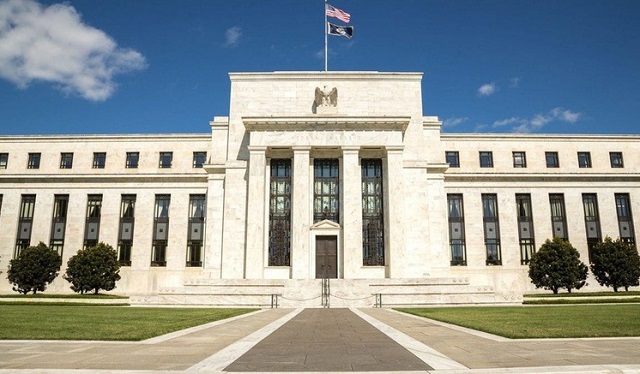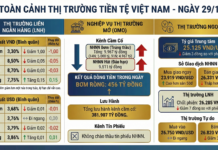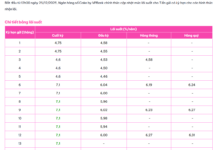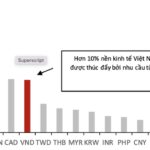
4 Key Impacts of Fed’s Interest Rate Cut on the Global and Vietnamese Economy and Finance
|
US Economic Background
The US macro-economy is relatively stable and has recovered well from the COVID-19 pandemic. The US economy grew by a solid 2.5% in 2023 (up from 1.9% in 2022) and continued to expand positively in the first three quarters of 2024 (with GDP growth of 3% in Q2, higher than the initially announced 2.8%, doubling the growth rate of Q1 (1.4%) and expected to be around 3% in Q3).
The US economic growth is projected to reach 2.5-2.7% for the full year 2024 and slow down to 1.8-2% in 2025. Inflation has sustainably declined to 2.9% in July and 2.5% in August, approaching the 2% target; the Personal Consumption Expenditures (PCE) price index also fell to 2.5% in July and is expected to be 2.4% in August, close to the 2% target (according to the US Department of Commerce).
However, the US economy faces some growing challenges, including instability in the manufacturing sector, which contracted for two consecutive months; the manufacturing PMI fell to 47.9 points in August from 49.6 points in July. The unemployment rate remains high at 4.2% in August, although slightly lower than the 4.3% recorded in July…
Three Main Reasons for the Fed’s Decision to Cut Interest Rates
After its regular meeting in September (September 17-18, 2024, US time), the US Federal Reserve (Fed) decided to cut the overnight lending rate (FedFunds rate) by 0.5 percentage points, bringing the rate to a range of 4.75-5%. The Fed also signaled its intention to continue lowering interest rates (expected to cut by another 0.5 percentage points by the end of 2024), with additional reductions of 1 percentage point in 2025 and about 0.5 percentage points in 2026, bringing the policy rate to a range of 3-3.5% by the end of 2026.
This is the first time the Fed has cut interest rates since March 2020, following 11 consecutive hikes since March 2022. The Fed had maintained the rate at a record high of 5.25-5.5% from July 2023 until now. The Fed’s monetary policy has shifted towards easing, supporting economic recovery and growth, job creation, while still controlling inflation risks.
The Fed’s decision to reverse its policy stance and initiate an interest rate cut cycle at this time is driven by three main reasons: First, inflation and the PCE price index (a key indicator for the Fed in adjusting interest rates) in the US have sustainably cooled down towards the 2% target, providing a basis for the Fed to consider adjusting its monetary policy, lowering interest rates to support economic recovery, boost growth, and ensure financial stability in the US and globally. Second, prior to this decision, several major central banks, including the European Central Bank (ECB), had already cut interest rates twice (by 0.25 percentage points each in June and September), while the central banks of the UK, Canada, Switzerland, and China had reduced rates by 0.25, 0.10, and 0.15 percentage points, respectively. Third, while the US economy is on a recovery path, the unemployment rate remains high at 4.2% in August, and consumer spending is weak.
Fiscal and financial risks in the US remain elevated, with public debt reaching a peak of 124% of GDP and private debt at 145% of GDP as of June 2024 (according to the Fed). Lowering the policy rate reduces the debt servicing burden on the government, individuals, and businesses, thereby reducing financial risks and supporting sustainable economic recovery and growth.
The Fed’s 0.5 percentage point rate cut is considered in line with market expectations in recent weeks, although it may have come as a slight surprise to some investors and experts who predicted a more modest 0.25 percentage point reduction.
Our research group identifies three main reasons for this significant cut: (i) US inflation has sustainably cooled down; (ii) the US economy, particularly employment, manufacturing, and consumer spending, has not performed as well as expected (as analyzed above); and (iii) the Fed appeared to be slightly behind some other major central banks in cutting interest rates. Moreover, with only two more meetings left in 2024 (in November and December), the Fed needed to take more aggressive action to align with its policy roadmap for 2024 and beyond.
Four Key Impacts on the Global Economy and Finance
First, the reduction in the policy rate sets the direction for other interest rates (savings, lending, and investment) to follow suit, thereby stimulating investment and consumer demand, boosting economic growth, creating jobs, and increasing income for individuals and businesses in the medium term while keeping inflation under control, given the relatively stable global commodity prices in the past and the foreseeable future.
Second, it contributes to lowering the overall interest rate, capital cost, and investment cost. The Fed’s rate cut also encourages other major central banks (except Japan) to follow suit, thereby reducing the overall interest rate environment, capital cost, and investment cost, especially as many countries (including the US) are facing high public and private debt levels. Lower interest rates reduce debt servicing burdens and stimulate new borrowing for investment, production, and consumption, fostering economic growth.
Third, it eases exchange rate pressure and provides reassurance to importers and investors. The Fed’s rate cut leads to a weaker US dollar, which boosts US exports while reducing exchange rate pressure on many other currencies (many of which have appreciated, including the VND), lowering import costs, exchange rate risks, and providing a sense of relief to importers and investors (including FDI inflows). In fact, the US Dollar Index fell by 4.6%, and currencies such as the JPY appreciated by about 10%, while the VND strengthened by 3% against the USD in the past three months (according to Bloomberg).
Fourth, regarding global stock markets, in the short term, the Fed’s aggressive rate cut did not cause significant disruptions as it followed a well-communicated roadmap and was anticipated by the markets. Immediately after the Fed’s decision, stock markets in the US and many other countries rallied (as it met market expectations), but they later reversed course and declined slightly or rose marginally (US stock indices fell by 0.25-0.3% on September 18, US time, while the Shanghai index dropped by 0.25%, and the Nikkei 225 and Hang Seng indices gained 2% and 0.22%, respectively…). This can be explained by the initial excitement wearing off as the market digested the news, especially with the Fed’s significant rate cut and expectations of slower US economic growth (although not a recession)…
In the medium term, observing the performance of stock markets after the Fed’s previous rate cut cycles, US stocks tend to rise by about 5% after three months and around 11% after twelve months. However, with this rate cut cycle, our research group forecasts a more modest increase of 3-4% after three months and 5-7% after one year, as stocks have already rallied significantly in the past year.
Four Key Impacts on the Vietnamese Economy and Finance
First, the downward trend in global interest rates will stimulate consumer demand, investment, production, and business activities of enterprises and individuals. This will help sustain economic growth and enhance resilience, boost demand for goods and services, thereby increasing Vietnam’s export potential, given the high degree of openness of the Vietnamese economy and the fact that the US and Europe are Vietnam’s leading export markets (in the first eight months of 2024, Vietnam’s exports to the US grew by 25.4%, accounting for 29% of total exports, while exports to Europe increased by 18.5%, making up 13% of the total). Additionally, FDI inflows into emerging markets, including Vietnam, are expected to rise.
Second, it eases exchange rate pressure. The Fed’s rate cut leads to a weaker US dollar against most other currencies (including the VND), reducing upward pressure on the USD/VND exchange rate. In fact, the market has already priced in a significant portion of this move, with the exchange rate cooling down from a peak of about 4.9% in late May 2024 to 1.6% as of September 18, 2024. The USD/VND exchange rate is expected to increase by only about 1.3-1.7% for the full year 2024.
A more stable exchange rate helps reduce import costs, while the impact on Vietnam’s exports is limited due to the structure of the economy. Our 2022 research on the relationship between exchange rates and Vietnam’s international trade balance from 2006 to 2021 found a loose correlation, as exchange rate fluctuations do not significantly affect Vietnam’s exports and imports for two main reasons: (i) Vietnam’s exports are mainly driven by FDI enterprises (accounting for over 70% of total export turnover from 2011 to 2022); these enterprises also import a significant portion of their inputs (about 55% of total imports) regardless of exchange rate movements, and they have the advantage of accessing USD capital from their parent companies; (ii) enterprises and financial organizations are increasingly concerned about and have more tools to manage exchange rate risks (including derivative financial instruments).
Third, it contributes to stabilizing the overall interest rate environment, reducing foreign currency borrowing costs for businesses in Vietnam. The Fed’s rate cut will lead to a cooling down of global interest rates as mentioned above. In Vietnam, foreign currency interest rates (especially USD and EUR) will decline, helping stabilize the overall interest rate environment (amid rising VND deposit rates) and reducing borrowing costs for existing and new foreign currency loans (according to the State Bank of Vietnam, the dollarization rate or USD borrowing in Vietnam currently stands at about 6.4% of total outstanding loans to the economy). Additionally, the government’s and FDI enterprises’ borrowing costs in foreign currency will also decrease partially. This will help reduce debt risks and stimulate credit demand and investment in the coming time.
Fourth, it has a positive impact on the stock market and investment flows, especially indirect foreign investment. In the first eight months of the year, the Vietnamese stock market continued its recovery despite challenges. The VNIndex stood at 1,283.9 points, up 2.6% from the previous month and 13.6% from the beginning of the year.
However, foreign investors net sold VND 64 trillion (USD 2.6 billion) during this period, partly due to the high interest rate differential between the USD and VND in the past. As the Fed and central banks in developed countries begin to lower interest rates, the interest rate differential will narrow, and the trend of capital outflows from emerging markets (including Vietnam) to seek safer investments in the US and other developed markets to benefit from higher interest rates will diminish. Moreover, Vietnamese stocks are relatively attractive, and there are expectations that Vietnam’s stock market could be upgraded from frontier to secondary emerging market status by the FTSE Russel in 2025… In fact, since the beginning of September 2024, foreign investors have started to net buy again.
Three Recommendations for Vietnam
As analyzed above, the Fed’s initiation of an easing monetary policy cycle (interest rate cuts) will generally have positive impacts on the global and Vietnamese economy and finance, but there are still many unpredictable risks and challenges. To ensure the achievement of economic development goals and targets set by the National Assembly and the Government, our research group proposes three recommendations:
First, ministries, sectors, and localities should continue to seriously implement Resolution 01 and 02/NQ-CP dated January 5, 2024, and other resolutions, decrees, and directives of the Party, National Assembly, and Government, especially focusing on overcoming the aftermath of Storm No. 3; closely monitoring, analyzing, and forecasting the international economic and financial situation; and developing appropriate response scenarios. It is also crucial to accelerate the removal of obstacles and bottlenecks, promote stabilization, and foster the healthy development of the financial, real estate, and gold markets to support economic growth, control inflation, and maintain macroeconomic stability for the whole year of 2024 and beyond.
Second, enhance the effectiveness of policy implementation and coordination (especially between monetary, fiscal, price management, and other macroeconomic policies) to promote economic growth, control inflation, maintain macroeconomic stability, stabilize exchange rates, and ensure the stability of the financial and monetary markets, as well as social security. In this regard, fiscal policy should remain the key driver, expanding in a focused and targeted manner, in conjunction with accelerating public investment disbursement; monetary policy should be proactive and flexible, improving credit access while managing risks and addressing bad debts. The government should ensure the adequate supply of essential goods and services (especially food, electricity, and fuel…) while carefully managing the timing and pace of price adjustments for goods under state control, strengthening market inspection and supervision, and communicating effectively to minimize speculation, hoarding, and price gouging in the aftermath of the recent storm and the implementation of the roadmap for wage increases.
Third, maintain the monetary policy stance as in the previous time, continuing to flexibly use various tools to stabilize interest rates, exchange rates, and the foreign exchange, gold, and financial markets, contributing to economic growth and inflation control within the set targets. The government should prioritize measures to upgrade the stock market to take advantage of international investment reallocation and manage risks in the interest rate reduction cycle as mentioned above.
Dr. Can Van Luc and BIDV Training and Research Institute Research Group
Can a Fed-Led Rate Cut Spark a 1990s-Style Boom in the US Economy?
The Federal Reserve (Fed) was applauded for its deft management of the US economy in 1995, engineering a soft landing that paved the way for the subsequent boom years.
The American Dream: Elevating Vietnamese Exports
The strong demand for “Made in Vietnam” products from American consumers has boosted the country’s export recovery to the US. Exports, which had declined by 21% in the first seven months of 2023, surged to a 24% increase in the same period this year, propelling manufacturing activity to a robust 10% growth.










































